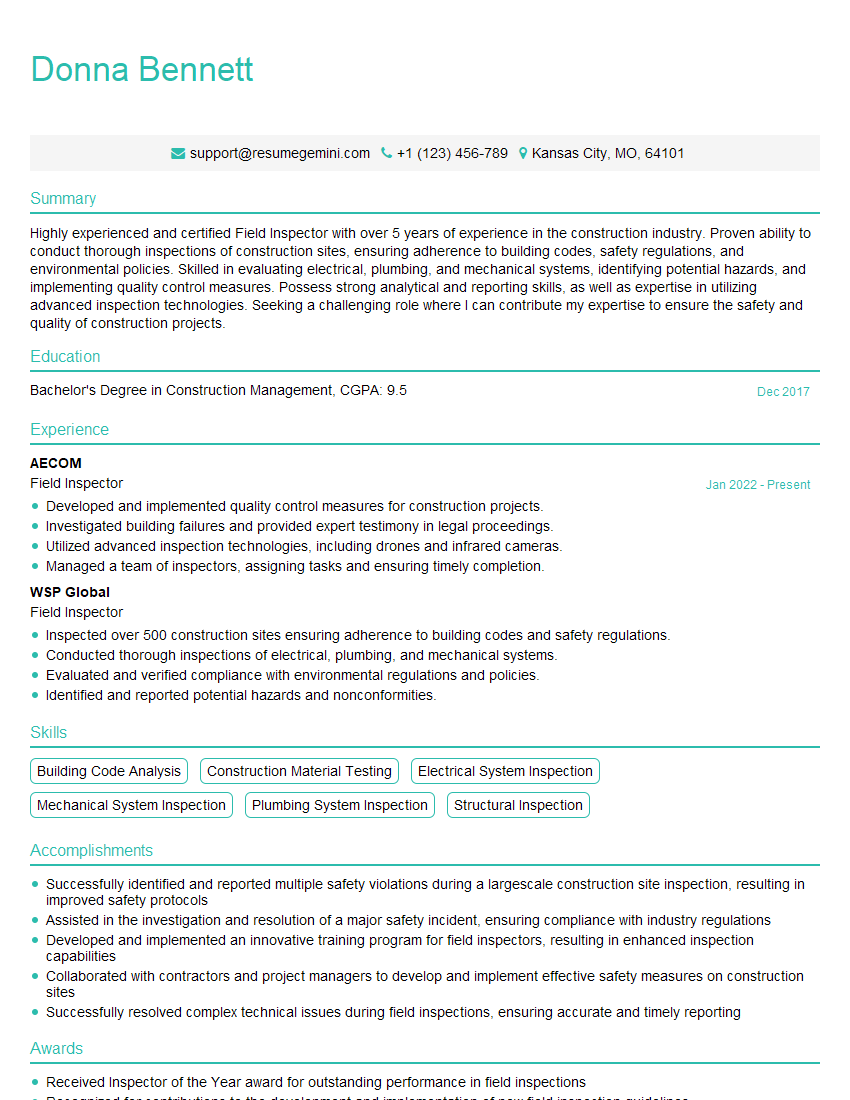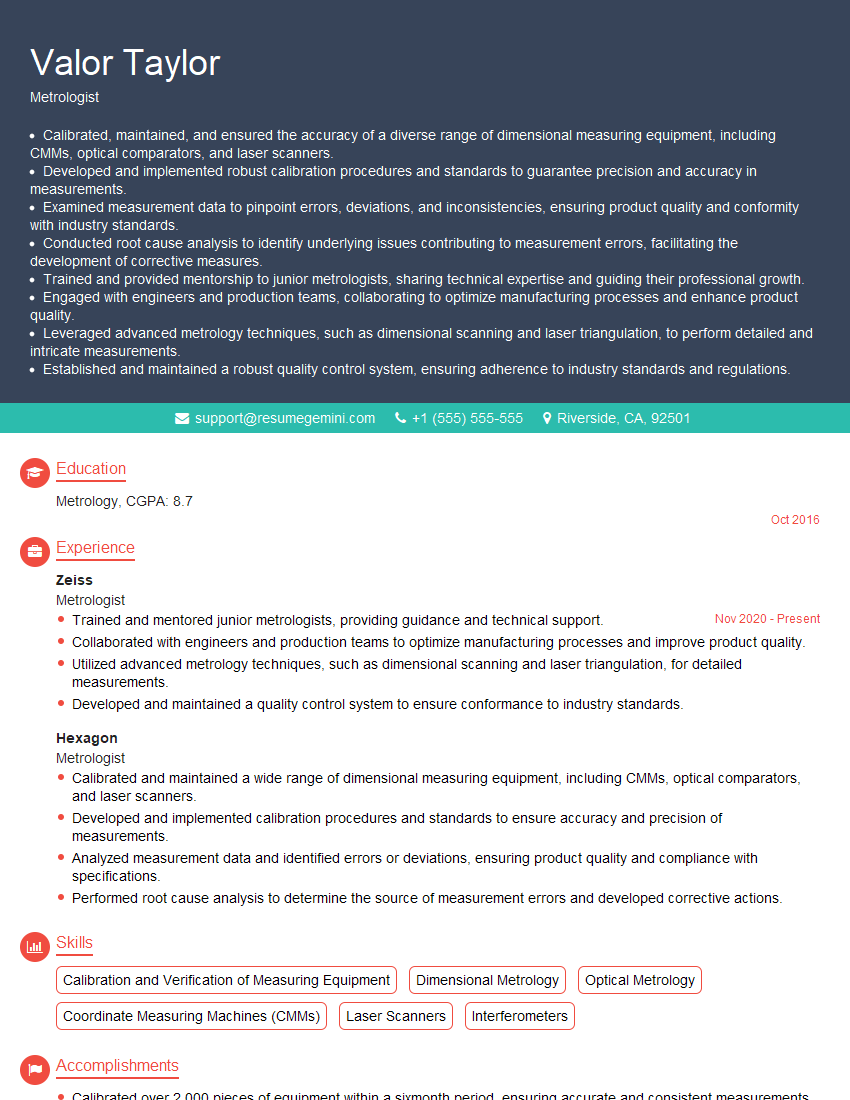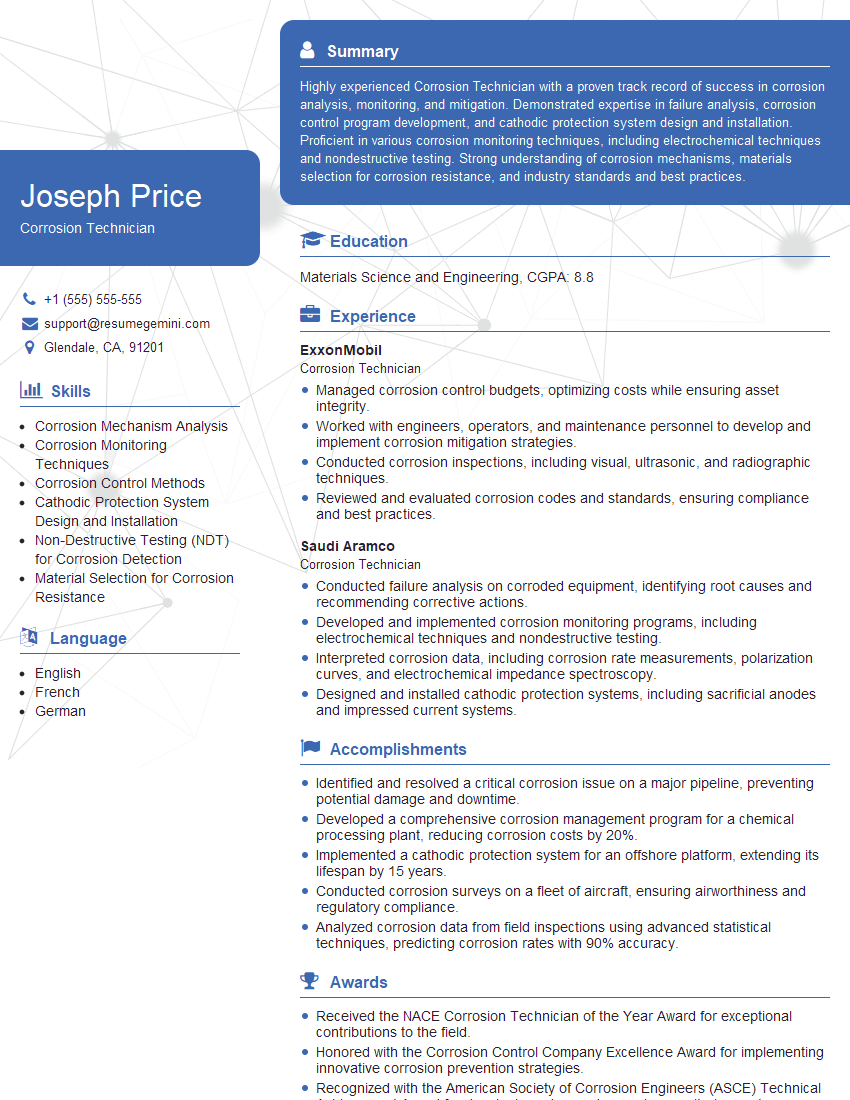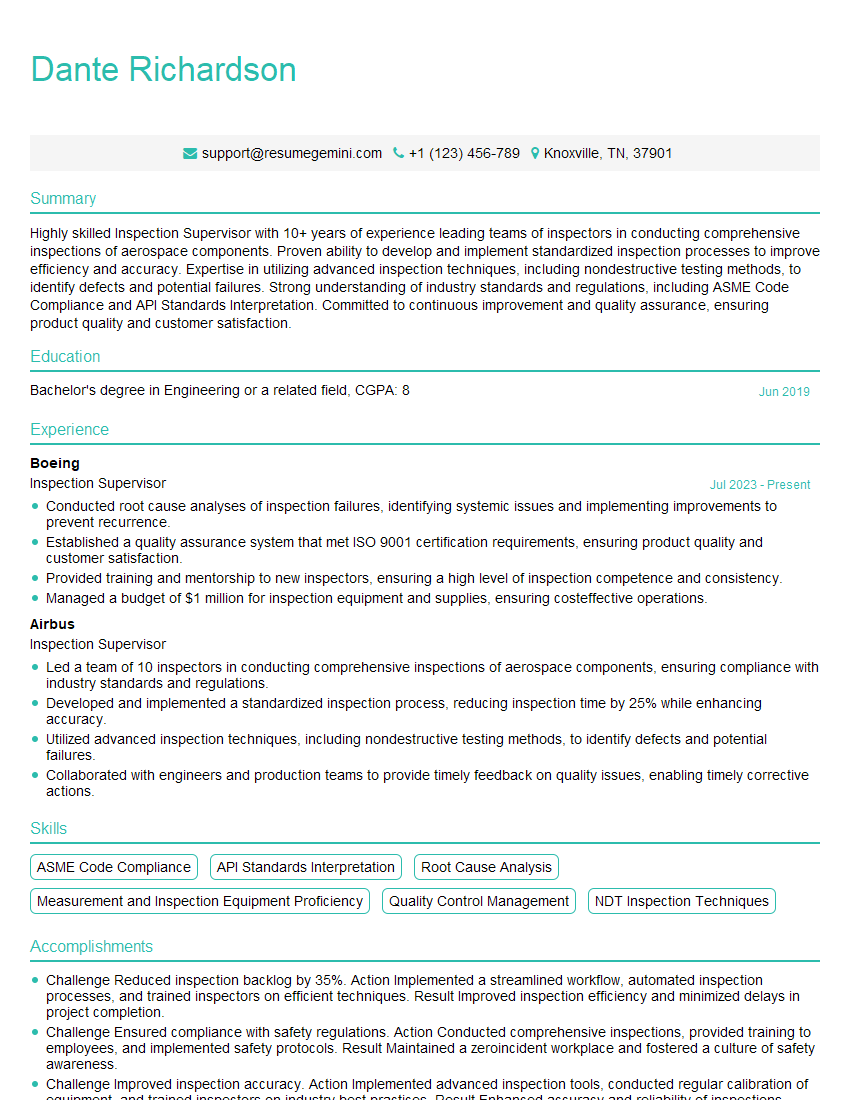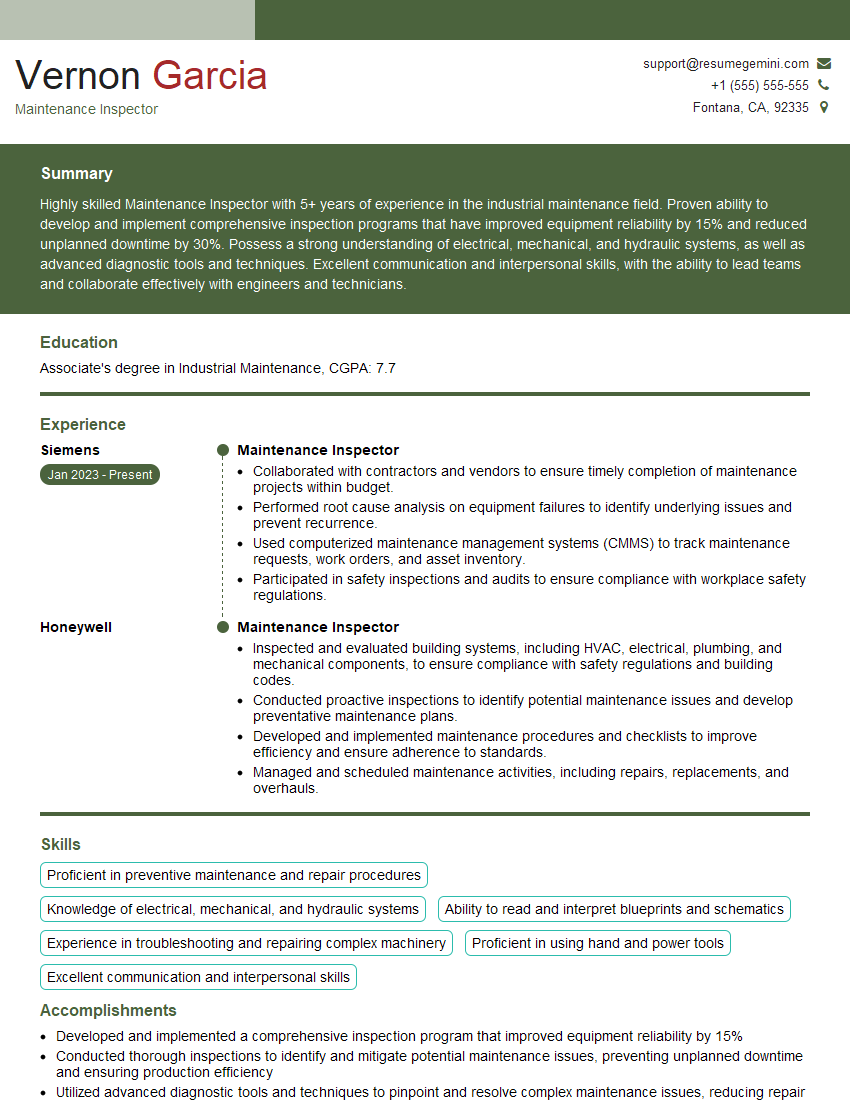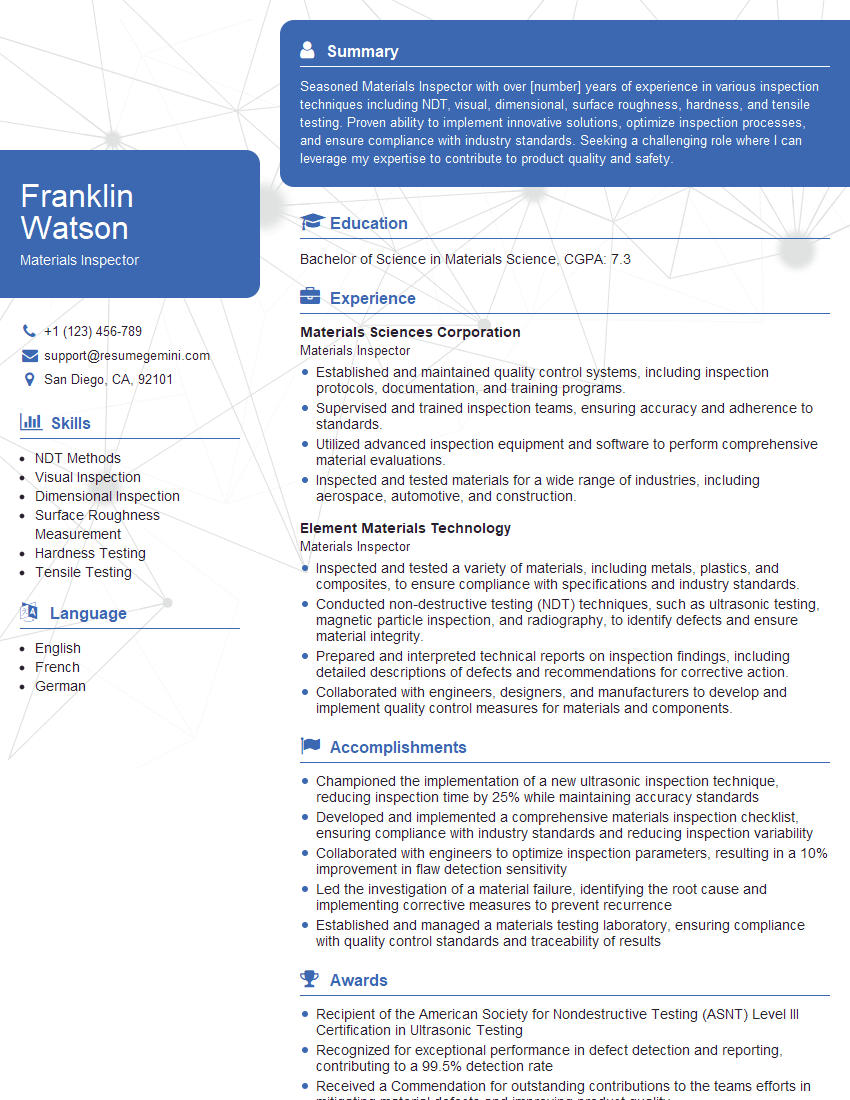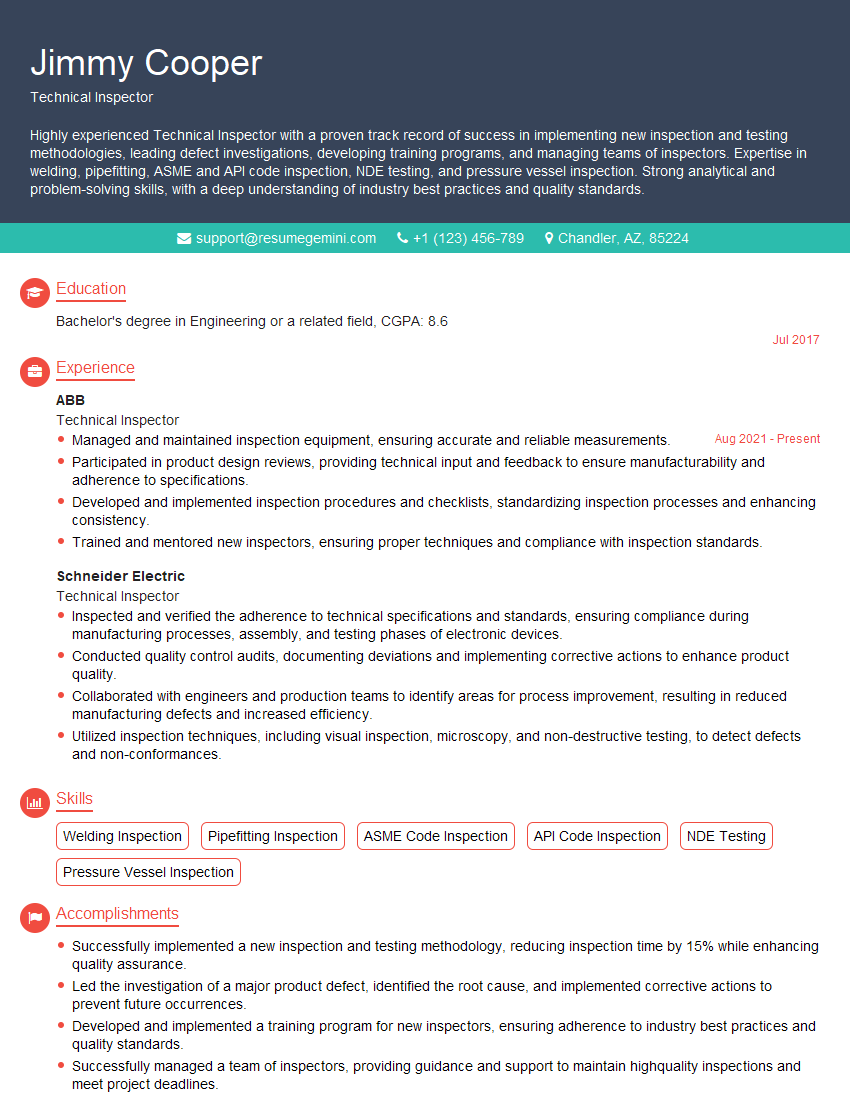Feeling uncertain about what to expect in your upcoming interview? We’ve got you covered! This blog highlights the most important Coating Thickness Inspection interview questions and provides actionable advice to help you stand out as the ideal candidate. Let’s pave the way for your success.
Questions Asked in Coating Thickness Inspection Interview
Q 1. Explain the different methods for measuring coating thickness.
Measuring coating thickness is crucial in various industries to ensure quality, performance, and safety. Several methods exist, each with its strengths and weaknesses. They broadly fall into two categories: destructive and non-destructive.
- Destructive Methods: These involve removing a sample of the coating and measuring its thickness directly using a microscope or cross-sectioning techniques. This provides highly accurate measurements but is wasteful and can’t be used on finished products.
- Non-Destructive Methods: These are preferred for their speed, convenience, and ability to test without damaging the coated item. Common non-destructive methods include:
- Magnetic Methods: Used for ferromagnetic coatings on ferromagnetic substrates.
- Eddy Current Methods: Used for non-ferromagnetic coatings on conductive substrates.
- Ultrasonic Methods: Used for various coatings and substrates, offering high precision even on complex geometries.
- Beta Backscatter Methods: Measures the thickness of non-conductive coatings on any substrate.
The choice of method depends heavily on the specific coating and substrate materials, the desired accuracy, and the accessibility of the coated surface.
Q 2. Describe the principles behind magnetic and eddy current methods.
Magnetic and eddy current methods are based on distinct electromagnetic principles:
- Magnetic Methods: These methods utilize a magnetic field to measure the thickness of ferromagnetic coatings (like iron, nickel, or cobalt) on ferromagnetic substrates (like steel). A probe with a permanent magnet or an electromagnet is placed on the coating. The force of attraction between the magnet and the substrate is measured; the thicker the coating, the weaker the force. The device correlates this force with the coating thickness. Think of it like trying to pull a magnet through a pile of iron filings – the more filings (coating), the harder it is to pull.
- Eddy Current Methods: This technique uses an electromagnet to induce eddy currents in a conductive substrate. A coil in the probe generates a high-frequency alternating magnetic field, creating eddy currents in the conductive substrate. The presence of a non-ferromagnetic coating (e.g., zinc, copper, aluminum) alters the impedance of the coil, which is directly proportional to the coating thickness. It’s like sensing a change in the electrical resistance of a wire based on an insulator layer wrapped around it.
Q 3. What are the limitations of each coating thickness measurement method?
Each method has its limitations:
- Magnetic Methods: Only suitable for ferromagnetic coatings on ferromagnetic substrates. Accuracy can be affected by substrate curvature, surface roughness, and the presence of other magnetic materials.
- Eddy Current Methods: Requires a conductive substrate. The presence of multiple layers or highly textured surfaces can affect accuracy. Also, it is less sensitive to thin coatings.
- Ultrasonic Methods: Can be more expensive and require specialized training. Coupling the probe properly to the surface is crucial for accurate readings.
- Beta Backscatter Methods: Requires proper safety precautions due to the use of radioactive isotopes. Surface roughness and coating density can impact accuracy.
Understanding these limitations is critical for selecting the appropriate method and interpreting the results correctly.
Q 4. How do you select the appropriate method for a specific coating and substrate?
Selecting the right method involves considering several factors:
- Coating Material: Ferromagnetic, non-ferromagnetic, conductive, non-conductive.
- Substrate Material: Ferromagnetic, non-ferromagnetic, conductive, non-conductive.
- Coating Thickness Range: Different methods have different optimal thickness ranges.
- Surface Condition: Roughness, curvature, and presence of other layers.
- Desired Accuracy: The precision needed for the application.
- Cost and Availability of Equipment: Some methods are more expensive or require specialized training.
For example, for measuring zinc coating on steel, an eddy current method would be appropriate. However, for measuring paint on aluminum, an ultrasonic method might be more suitable.
Q 5. What are the common standards and specifications for coating thickness?
Numerous standards and specifications govern coating thickness measurement, ensuring consistency and comparability across different industries and applications. These standards dictate the acceptable measurement methods, tolerances, and reporting procedures. Examples include:
- ASTM (American Society for Testing and Materials): Provides numerous standards related to coating thickness measurement, including ASTM B499 (magnetic method), ASTM B244 (eddy current method), and ASTM D1186 (ultrasonic method).
- ISO (International Organization for Standardization): Offers equivalent international standards for coating thickness measurement.
- Industry-Specific Standards: Various industries have their own specific standards for coating thickness based on the application (e.g., automotive, aerospace).
Adhering to these standards is essential for quality control and compliance.
Q 6. Explain the importance of proper surface preparation before coating thickness measurement.
Proper surface preparation is paramount for accurate coating thickness measurement. Surface imperfections, contaminants, and unevenness can significantly affect the measurement results. The preparation steps might include:
- Cleaning: Removing dirt, grease, rust, and other contaminants using appropriate solvents or cleaning methods.
- Surface Roughness Assessment: Checking the surface roughness to determine if it’s within acceptable limits for the chosen measurement method.
- Substrate Condition Evaluation: Assessing the condition of the underlying substrate to identify any potential issues that might impact measurement accuracy.
Failing to properly prepare the surface can lead to inaccurate readings and flawed quality control assessments. Think of it like trying to measure the thickness of a sheet of paper if it’s crumpled – you won’t get a reliable reading.
Q 7. How do you calibrate and maintain coating thickness measurement equipment?
Regular calibration and maintenance are crucial for ensuring the accuracy and reliability of coating thickness measurement equipment. This typically involves:
- Regular Calibration: Using certified calibration standards (e.g., calibration foils with known thicknesses) to verify the accuracy of the instrument. The frequency of calibration depends on the equipment and usage but is often monthly or annually.
- Cleaning and Maintenance: Keeping the probes and instrument clean and free from damage. This often includes gently cleaning the probes after each use and regularly inspecting for any wear or damage.
- Periodic Servicing: Having the equipment serviced by a qualified technician at recommended intervals to ensure its proper functioning and to detect and address any potential problems.
- Following Manufacturer’s Instructions: Always consult and meticulously follow the manufacturer’s recommendations for calibration and maintenance procedures.
Neglecting calibration and maintenance can lead to inaccurate measurements, costly errors, and potential safety hazards.
Q 8. Describe the different types of probes used in coating thickness measurement.
Coating thickness measurement relies on different probe types, each suited for specific coating and substrate materials. The choice depends on factors like coating conductivity, substrate material, and desired accuracy.
- Magnetic Probes: These are ideal for measuring non-magnetic coatings on ferrous substrates (like paint on steel). They work by measuring the attractive force between a magnet and the ferrous substrate. The thicker the coating, the weaker the magnetic force.
- Eddy Current Probes: These are best for measuring non-magnetic coatings on non-ferrous substrates (like paint on aluminum or zinc). They induce eddy currents in the substrate, and the strength of these currents is affected by the coating thickness. More coating means weaker eddy currents.
- Ultrasonic Probes: These use sound waves to measure coating thickness, making them suitable for various coating and substrate combinations, including thick coatings or those on complex geometries. They are more versatile but can be more complex to operate and calibrate.
For example, when inspecting a car’s painted body, a magnetic probe would be suitable for measuring the paint thickness on the steel panels. However, for measuring the anodizing layer on an aluminum part, an eddy current probe would be necessary.
Q 9. How do you interpret the results of a coating thickness measurement?
Interpreting coating thickness measurement results involves comparing the measured values to the specified or accepted range. This requires understanding the tolerances set by the relevant standards or specifications for the coating application.
Firstly, ensure the readings are within acceptable limits. If a measurement falls outside the specified range, it indicates potential issues. For instance, a paint coating too thin may lack proper protection against corrosion, whereas a coating that’s too thick could be wasteful and affect the product’s aesthetics or functionality.
Secondly, look for trends or patterns in the data. Consistent deviations in thickness could point towards problems in the coating process. For example, consistently thin readings might suggest the application equipment needs calibration or the material flow requires adjustment. We also document the location of each measurement to understand the uniformity of the coating across a surface.
Lastly, always consider the measurement uncertainty, as no measurement is perfectly accurate. This involves understanding the instrument’s precision and the potential sources of error described in the next question. The results are documented alongside the measurement uncertainty to showcase their reliability and provide a comprehensive picture of the coating’s characteristics.
Q 10. What are the potential sources of error in coating thickness measurement?
Several factors can introduce errors in coating thickness measurements. These need careful consideration to ensure the accuracy and reliability of the data.
- Probe Calibration: Incorrectly calibrated probes lead to inaccurate readings. Regular calibration against certified standards is essential.
- Surface Preparation: Rough or uneven surfaces can affect probe contact and introduce errors. Proper surface cleaning is therefore crucial.
- Substrate Variations: Variations in substrate material properties (e.g., different alloys of steel) can influence the measurement. Understanding the substrate’s composition is critical.
- Temperature and Humidity: Environmental factors can influence measurement outcomes; maintaining a stable environment is ideal.
- Operator Skill: Operator technique and consistency in probe application significantly impact accuracy. Proper training is essential.
- Probe Selection: Choosing the wrong probe type for the coating and substrate combination can result in significantly inaccurate or impossible measurements.
For example, a rusty surface will give false readings if not properly cleaned before measurement. Similarly, incorrect probe selection will lead to flawed data from the outset.
Q 11. How do you handle outliers or inconsistencies in measurement data?
Handling outliers and inconsistencies starts with investigating their potential causes. Simple mistakes in data entry are sometimes the culprit; always double-check your records. Once identified, the next step is crucial.
Investigation: Examine the conditions under which the outliers were recorded. Was there a change in environmental conditions, a different operator, or a problematic area of the surface?
Verification: Re-measure the outliers using the same or a different probe. If the outlier persists, take more measurements in the immediate vicinity to determine whether it’s a localized variation or a systematic problem.
Data Exclusion (with Caution): In some cases, after thorough investigation, outliers might be excluded from the overall analysis. However, it’s important to document the reasons for exclusion and the impact on the overall results. We can’t simply discard outliers without a valid reason; otherwise it can bias our assessment.
Statistical Analysis: Statistical methods like standard deviation analysis and control charts can help identify significant inconsistencies, guiding further investigation and remedial actions. A systematic approach to data review is essential to reach accurate conclusions.
Q 12. Describe your experience with different types of coatings (e.g., paint, powder, plating).
My experience encompasses a wide range of coatings, each presenting unique challenges and measurement considerations.
- Paints: I have extensive experience measuring the thickness of various paint types, from automotive finishes to industrial coatings. Understanding the specific paint characteristics—such as its composition (solvent-based vs. water-based) and cure time—is essential for accurate measurement.
- Powder Coatings: Powder coatings require careful attention to surface preparation. The technique for measurement needs to ensure accurate readings because of the unique texture and potential irregularities of the coating.
- Plating: Electroplated coatings, like chrome or nickel, often necessitate eddy current probes. Precise measurements are critical to ensure adherence to quality standards.
In one project, we were measuring the thickness of a specialized powder coating on a complex-shaped component. We had to adapt our measurement technique to ensure uniform coverage and adequate thickness across all surfaces, utilizing specialized probes and software.
Q 13. What are the safety precautions associated with coating thickness measurement?
Safety is paramount during coating thickness measurements. Several precautions must be followed to mitigate potential risks.
- Electrical Safety: Eddy current probes utilize electricity, so it’s crucial to use properly grounded equipment and follow established electrical safety protocols to avoid shock or equipment damage.
- Personal Protective Equipment (PPE): Depending on the application and the environment, appropriate PPE like safety glasses and gloves should be worn. This protects against potential hazards like chemical splashes or sharp edges.
- Working Environment: Ensure that the area is well-ventilated, especially when measuring coatings containing volatile organic compounds (VOCs). Proper lighting also enhances accuracy and safety.
- Calibration and Maintenance: Regular probe calibration and equipment maintenance help avoid potential equipment malfunctions and ensure data reliability.
For example, when measuring coatings in a confined space or near potentially hazardous chemicals, appropriate respiratory protection is mandatory.
Q 14. How do you document and report your coating thickness measurement findings?
Proper documentation and reporting are crucial for maintaining traceability and facilitating accurate interpretation of coating thickness measurements. A well-structured report includes the following elements:
- Project Identification: Unique project identifier, date, location, and client information.
- Instrument Details: Make, model, and serial number of the equipment used. Calibration details and date should also be clearly stated.
- Methodology: Clear description of the measurement technique used, including probe type and specifics of surface preparation.
- Measurement Data: A table or spreadsheet presenting the measured coating thickness values, alongside their locations and any relevant annotations. Include the measurement uncertainties for each reading.
- Statistical Analysis: Summary statistics like average, standard deviation, minimum, and maximum thickness values to facilitate the interpretation of the data.
- Photographs or Visual Aids: Pictures or sketches of the components measured, showing the location of each measurement. This provides a visual context to the results.
- Conclusion and Recommendations: Summary of the findings, identifying areas of concern (if any), and suggestions for corrective action if the measured thickness falls outside the acceptable range.
The report should be well-organized, easy to understand, and formatted to meet any relevant industry standards.
Q 15. Explain the relationship between coating thickness and corrosion protection.
The relationship between coating thickness and corrosion protection is fundamentally direct and proportional. A thicker coating, assuming it’s properly applied and of good quality, provides a more substantial barrier between the substrate (the material being protected) and the corrosive environment. Think of it like a wall – the thicker the wall, the more difficult it is for an attacker to breach it. Corrosion is essentially a chemical attack on the substrate, and a thicker coating minimizes the surface area exposed to this attack and increases the time it takes for corrosion to penetrate.
For example, a thin coating on a steel pipe might fail relatively quickly in a harsh environment like a saltwater pipeline, while a thicker coating of the same material will offer significantly longer protection. The optimal thickness depends on many factors, including the corrosive environment, the substrate material, and the coating type. Industry standards and specifications often define minimum acceptable thicknesses for different applications.
Career Expert Tips:
- Ace those interviews! Prepare effectively by reviewing the Top 50 Most Common Interview Questions on ResumeGemini.
- Navigate your job search with confidence! Explore a wide range of Career Tips on ResumeGemini. Learn about common challenges and recommendations to overcome them.
- Craft the perfect resume! Master the Art of Resume Writing with ResumeGemini’s guide. Showcase your unique qualifications and achievements effectively.
- Don’t miss out on holiday savings! Build your dream resume with ResumeGemini’s ATS optimized templates.
Q 16. How does coating thickness affect the overall performance of a coated part?
Coating thickness significantly impacts the overall performance of a coated part in several ways. Beyond corrosion protection (as discussed above), it affects:
- Durability: Thicker coatings are generally more resistant to mechanical damage, such as scratches and abrasion. This is especially critical for parts subject to wear and tear.
- Aesthetics: For decorative coatings, thickness can influence the final appearance. Uniform thickness is crucial for a smooth, even finish, while variations can lead to defects.
- Adhesion: While not directly proportional, very thin coatings might have weaker adhesion to the substrate, increasing the risk of delamination (peeling). Conversely, excessively thick coatings can also lead to stress and cracking.
- Electrical properties: In applications involving electrical conductivity or insulation, the coating thickness will directly affect the performance. In the case of electrical insulation, a thicker layer provides better insulation properties.
- Cost: Naturally, thicker coatings require more material, thus increasing the cost of production.
Finding the optimal coating thickness involves careful consideration of all these factors to achieve the desired balance between protection, performance, and cost.
Q 17. Describe a situation where you had to troubleshoot a problem with coating thickness measurement equipment.
During a project involving the coating of large diameter steel pipes, we experienced inconsistent readings from our magnetic thickness gauge. Initially, we suspected a problem with the gauge itself, but after thorough calibration checks, the issue persisted. We systematically investigated several factors:
- Substrate Condition: We discovered that the surface preparation of the pipes was inconsistent. In some areas, there was insufficient surface cleaning and roughness which was interfering with the gauge’s ability to provide accurate readings.
- Gauge Technique: We also realized that operators were not using the gauge consistently, applying differing amounts of pressure to the probe.
- Environmental Factors: Changes in ambient temperature and humidity were also causing slight variations.
The solution involved improved surface preparation protocols, more stringent operator training on correct gauge usage, and taking measurements at a consistent temperature and humidity. Implementing these changes ensured that the gauge produced consistent and reliable results. This case highlighted the importance of controlling all variables when using coating thickness gauges and understanding potential sources of error.
Q 18. How do you ensure the accuracy and reliability of your coating thickness measurements?
Ensuring the accuracy and reliability of coating thickness measurements involves a multifaceted approach:
- Regular Calibration: Coating thickness gauges need periodic calibration against certified standards to ensure accurate readings. The frequency of calibration depends on the gauge type, usage frequency, and the criticality of the application.
- Proper Gauge Selection: The chosen gauge should be appropriate for the coating type (e.g., magnetic for ferrous metals, eddy current for non-ferrous metals, ultrasonic for thicker coatings or those on complex substrates).
- Controlled Environment: Environmental factors (temperature, humidity) can influence measurement accuracy, particularly for certain gauge types. Conducting measurements under controlled conditions minimizes these effects.
- Operator Training: Well-trained operators are essential for consistent and reliable measurements. Proper techniques for using the gauge and interpreting the results must be followed.
- Multiple Measurements: Taking multiple measurements at different locations on the coated part and averaging the results helps reduce the impact of localized variations and uncertainties.
- Statistical Analysis: Employing statistical process control (SPC) techniques helps identify trends and potential problems early on.
By adhering to these procedures, we significantly enhance the accuracy and reliability of our coating thickness measurements, ensuring the quality of our coated parts.
Q 19. What is the significance of adhesion testing in relation to coating thickness?
Adhesion testing is crucial because even the thickest coating will fail if it doesn’t adhere properly to the substrate. Poor adhesion can lead to premature coating failure due to delamination, significantly reducing the effectiveness of the coating and negating the benefits of the achieved thickness. Therefore, adhesion testing is inseparable from the assessment of coating quality and overall performance. It provides an independent validation of the coating process beyond simply measuring the thickness.
Different methods exist for adhesion testing, such as pull-off tests, scratch tests, and tape tests. The choice of method depends on the coating type, substrate material, and the desired level of detail. A good coating thickness measurement tells you *how much* coating is there, but adhesion testing tells you *how well* it’s attached.
Q 20. How familiar are you with statistical process control (SPC) in the context of coating thickness?
I’m very familiar with statistical process control (SPC) in the context of coating thickness. SPC is an essential tool for monitoring and improving the coating process by identifying and addressing variations in coating thickness. We use control charts (e.g., X-bar and R charts) to track the average and range of coating thickness measurements over time. This allows us to:
- Detect shifts in the process: Identify when the average coating thickness is drifting outside acceptable limits.
- Monitor process variability: Identify increasing variability in the coating thickness, indicating potential problems in the process.
- Prevent defects: By identifying problems early, corrective actions can be taken before they lead to a large number of non-conforming parts.
- Improve process capability: SPC helps determine the overall capability of the coating process to consistently produce coatings within the specified thickness range.
Example: We might set control limits for coating thickness based on historical data and specifications. If measurements fall outside these limits, it triggers an investigation into the root cause of the variation. This might involve recalibrating equipment, adjusting process parameters, or even investigating issues with the raw materials.
Q 21. Describe your experience with different types of coating thickness gauges (e.g., magnetic, eddy current, ultrasonic).
My experience encompasses several types of coating thickness gauges:
- Magnetic Gauges: These are commonly used for measuring the thickness of non-magnetic coatings on ferrous substrates (e.g., paint on steel). They work by measuring the magnetic force required to pull a probe away from the substrate, which is influenced by the coating thickness. I’m proficient in their use and understand their limitations, such as the inability to measure coatings on non-ferrous metals.
- Eddy Current Gauges: These are ideal for measuring the thickness of non-conductive coatings on non-ferrous substrates (e.g., paint on aluminum). They utilize electromagnetic induction to measure the change in impedance caused by the coating. I have extensive experience in using these gauges, including understanding the different probe types and their application to various materials and coatings.
- Ultrasonic Gauges: Ultrasonic gauges use high-frequency sound waves to measure the coating thickness. They are suitable for thicker coatings or those on substrates that are incompatible with magnetic or eddy current methods. I have used these gauges on diverse applications, including measuring the thickness of coatings on plastics and composite materials. I understand the principles behind the technique and the complexities of using them effectively.
Choosing the appropriate gauge is critical for accurate measurements and depends heavily on the materials involved. I have a strong understanding of the advantages and limitations of each gauge type and can select the most appropriate one for any given situation.
Q 22. What is your experience with data analysis and reporting of coating thickness measurements?
Data analysis and reporting in coating thickness inspection are crucial for ensuring quality control and identifying potential issues. My experience involves using statistical software packages like Minitab or JMP to analyze measurement data. This includes calculating descriptive statistics (mean, standard deviation, minimum, maximum), creating histograms and other visualizations to understand the distribution of coating thicknesses, and performing hypothesis testing to compare measurements across different batches, locations, or operators. Reporting typically includes detailed summaries of findings, graphical representations of the data, and conclusions regarding whether the coating meets specified standards. For example, I’ve used statistical process control (SPC) charts to monitor coating thickness over time, identifying trends and potential out-of-control conditions that require immediate attention. This proactive approach helps prevent defects and ensures consistent coating quality.
I also create customized reports tailored to client needs, which often include images from the inspection process and detailed explanations of any deviations from specifications. My reports are designed to be easily understandable by both technical and non-technical personnel, using clear language and visuals to communicate key findings effectively.
Q 23. How do you determine the appropriate sample size for coating thickness testing?
Determining the appropriate sample size for coating thickness testing is vital for obtaining statistically reliable results without unnecessary expense. The process depends on several factors: the acceptable level of error (confidence level), the variability of the coating process, and the desired precision of the estimate. I typically use statistical methods, such as power analysis, to determine the minimum number of measurements needed to achieve the desired accuracy. For example, if we need a high level of confidence (95%) and want to detect a small difference in coating thickness, a larger sample size will be required. Conversely, if the variability of the coating process is low and a less stringent accuracy is acceptable, a smaller sample size might suffice.
In practice, I consider the project’s specific requirements and use industry standards and guidelines as a starting point. For example, ASTM standards often provide guidance on sample size for specific coating types and applications. I then adapt this initial sample size based on the observed variability in the coating during the testing process. Regular audits of the sample size calculations are performed to guarantee the appropriate level of confidence is maintained over time.
Q 24. Explain the concept of destructive and non-destructive testing in relation to coating thickness.
Destructive and non-destructive testing (NDT) are two fundamental approaches to coating thickness measurement, each with its advantages and disadvantages. Non-destructive testing methods, such as magnetic induction, eddy current, and ultrasonic testing, measure the coating thickness without damaging the underlying substrate. These techniques are ideal for in-situ inspections where preserving the integrity of the coated component is crucial. For example, eddy current testing is widely used in the aerospace industry to inspect aircraft components without compromising their structural integrity.
Destructive testing, on the other hand, involves removing a small section of the coating to precisely determine its thickness through cross-sectional analysis using microscopy. This method provides highly accurate measurements but is inherently destructive, limiting its applicability. Destructive testing is frequently used for quality control purposes where a small sample can be sacrificed for comprehensive analysis, such as confirming the coating’s adhesion or composition. The choice between destructive and non-destructive methods depends on the specific application, the level of accuracy required, and the value of the coated component.
Q 25. How do you deal with complex geometries or difficult-to-access areas during coating thickness measurement?
Measuring coating thickness on complex geometries or in difficult-to-access areas requires specialized techniques and equipment. For intricate shapes, I often employ handheld gauges with various probes designed to adapt to curved surfaces or small crevices. For instance, magnetic gauges with small probe diameters can access tight spaces. Ultrasonic testing also offers flexibility in handling complex geometries as the sound waves can penetrate curved surfaces. In instances where direct access is limited, remote sensing techniques such as utilizing robotic arms with integrated sensors may be necessary.
For areas that are simply inaccessible, a combination of techniques might be necessary. For example, initial measurements could be made in accessible areas to establish a baseline, which can then be extrapolated, albeit with some assumptions and potential increased error, to areas that are inaccessible. Careful documentation of the methodology is crucial in this situation to clearly outline the limitations of the measurements.
Q 26. What are the key performance indicators (KPIs) you use to monitor the effectiveness of your coating thickness inspection?
Key performance indicators (KPIs) for coating thickness inspection are essential for monitoring the effectiveness of the process and ensuring consistent quality. Some of the most important KPIs include:
- Average coating thickness: Indicates the overall thickness of the coating.
- Standard deviation of coating thickness: Measures the variability in coating thickness, highlighting inconsistencies in the application process.
- Percentage of measurements within specification limits: Shows the proportion of measurements that fall within the acceptable range defined by the coating specifications.
- Number of rejected parts or samples: Indicates the frequency of coatings failing to meet the required standards.
- Inspection time per unit: Measures the efficiency of the inspection process.
Tracking these KPIs over time allows for identification of trends and improvement opportunities within the coating process. For example, consistently low average thickness might point towards insufficient coating material being used. A high standard deviation may signal issues with the coating application equipment or inconsistencies in the operator’s technique. Regular reviews of these KPIs ensure proactive adjustments are made to maintain optimal coating quality and process efficiency.
Q 27. Describe your experience with different types of substrates (e.g., steel, aluminum, plastics).
My experience encompasses a wide range of substrates, including steel, aluminum, plastics, and various composites. Each substrate presents unique challenges and requires adjustments in the inspection technique. For example, ferrous substrates like steel are ideal for magnetic techniques. However, non-ferrous metals, such as aluminum, necessitate the use of eddy current or ultrasonic methods. Plastics, due to their non-conductive and often variable nature, often demand more specialized approaches like ultrasonic techniques or even destructive testing methods.
The choice of method also depends on the coating type. For instance, measuring the thickness of a conductive coating on a non-conductive substrate requires different techniques compared to measuring a non-conductive coating on a conductive substrate. Furthermore, factors such as the substrate’s surface roughness, curvature, and temperature can influence the accuracy and reliability of the measurements. Understanding these interactions is paramount for obtaining reliable results.
Q 28. How do you stay up-to-date with the latest advancements and standards in coating thickness inspection?
Staying current in the dynamic field of coating thickness inspection is vital for maintaining expertise. I regularly participate in industry conferences and workshops, attending presentations and networking with professionals to learn about the latest advancements in equipment, techniques, and standards. I am also a member of professional organizations like [mention relevant professional organizations, e.g., ASTM International, NACE International], which provides access to technical publications, journals, and online resources detailing new developments and best practices.
In addition, I actively monitor industry publications and online resources to stay informed on emerging technologies, such as advanced sensor technologies and data analysis methods. I regularly review and update my knowledge of relevant standards and specifications (e.g., ISO, ASTM, etc.) to ensure my techniques align with the latest industry best practices and regulatory requirements.
Key Topics to Learn for Coating Thickness Inspection Interview
- Destructive vs. Non-Destructive Testing Methods: Understand the principles and applications of different methods like magnetic induction, eddy current, and ultrasonic testing. Compare their advantages and limitations for various coating types and substrates.
- Calibration and Standardization: Learn about the importance of proper instrument calibration and the use of standards to ensure accurate and reliable measurements. Be prepared to discuss calibration procedures and troubleshooting calibration issues.
- Data Interpretation and Analysis: Practice interpreting coating thickness data, identifying trends, and recognizing anomalies. Understand how to present data effectively and draw meaningful conclusions.
- Coating Types and Properties: Familiarize yourself with different types of coatings (e.g., metallic, polymeric, paint) and their impact on measurement techniques. Understand the relationship between coating thickness and coating performance.
- Substrate Materials and Effects: Learn how different substrate materials (e.g., steel, aluminum, plastics) affect coating thickness measurements and the potential for measurement errors. Understand how to account for these effects.
- Quality Control and Assurance: Understand the role of coating thickness inspection in maintaining product quality and meeting industry standards. Be prepared to discuss quality control procedures and their importance in manufacturing processes.
- Troubleshooting and Problem Solving: Develop your ability to identify and troubleshoot common problems encountered during coating thickness inspection, such as inaccurate measurements, instrument malfunctions, and sample preparation issues.
- Safety Procedures and Regulations: Understand relevant safety regulations and procedures associated with coating thickness inspection equipment and materials.
Next Steps
Mastering Coating Thickness Inspection opens doors to rewarding careers in quality control, manufacturing, and materials science. A strong understanding of these principles is highly sought after by employers. To maximize your job prospects, creating an ATS-friendly resume is crucial. ResumeGemini is a trusted resource to help you build a professional and impactful resume that gets noticed. We provide examples of resumes tailored to Coating Thickness Inspection to guide you. Invest time in crafting a compelling resume – it’s your first impression and a key to unlocking your career potential.
Explore more articles
Users Rating of Our Blogs
Share Your Experience
We value your feedback! Please rate our content and share your thoughts (optional).
What Readers Say About Our Blog
Hi, I represent an SEO company that specialises in getting you AI citations and higher rankings on Google. I’d like to offer you a 100% free SEO audit for your website. Would you be interested?
good


